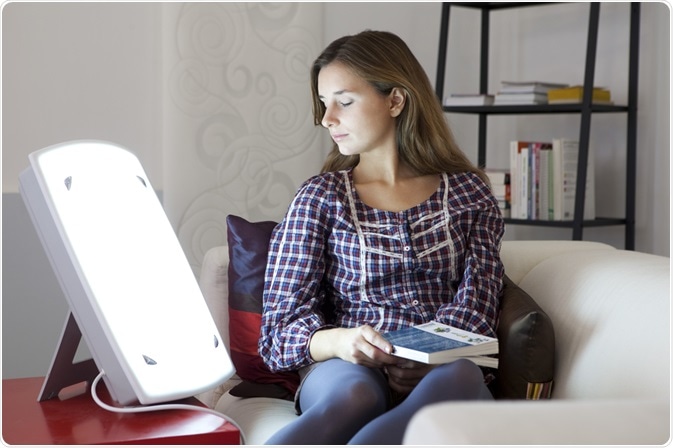Light therapy can be defined as exposure to daylight or specific wavelengths of light for a prescribed amount of time in order to treat seasonal affective disorder, acne, and a myriad of other conditions. Even though this type of treatment is generally very safe, negative effects may occur.

Image Credit: Image Point Fr / Shutterstock.com
As a consequence of light therapy, patients can complain of irritability, headaches, eye strain, sleep disturbances, and insomnia. Mild visual side effects are not unusual but remit promptly. Therefore, determining the appropriate dose and timing of light is essential in order to diminish the occurrence of such side effects.
Safety measures
The major contraindications for the use of light therapy are diseases that involve the retina of the eye, such as diabetes, and the use of photosensitizing medications like lithium, melatonin, phenothiazine antipsychotics, and certain antibiotics. People with a history of skin cancer and systemic lupus erythematosus should also avoid this kind of treatment.
Phototherapy requires special technical equipment and trained staff. Full-spectrum bulbs can result in sunburns if the light does not have a diffuser that filters out the ultraviolet (UV) rays. This is the reason why lamps used in modern light therapy filter out UV light considerably and are thought to be safer.
When photodynamic therapy is pursued, physical hazards such as non-ionizing radiation produced by the light-emitting device, as well as chemical hazards, such as undesirable exposure to photosensitizing agents applied to patients, must be considered for safe use by the healthcare professional.
Personal protective equipment for photodynamic therapy should include eye and skin protection from chemicals and non-ionizing radiation. Engineering and administrative equipment controls that are recommended for safe use should be strictly followed.
Adequate coverage of the skin must be taken into account, and appropriate material should be used to prevent penetration of photosensitizing agents. Hence, there is a need for laboratory coats or other suitable clothing that can cover as much exposed skin as possible, and also block the incoming radiation.
Ability of a fabric to protect against radiation is often measured by the UV protection factor (UPF), which indicates how much of the effective UV dose gets absorbed to protect the skin. The rating is usually based on the fiber density and structure, although pre-treatment with a UV-inhibiting agent is also an option.
Mayo Clinic Minute: Lift your mood with light therapy
Side effects of light therapy
Light therapy that involves only visible light is generally considered safe. Still, the use of phototherapy for people with drug-resistant non-seasonal depression can result in a hyperactive state called mania. In these rare cases, light therapy must be reduced or stopped and the condition adequately treated.
Any treatment where the patient is exposed to UV radiation is not completely without its risks. To this end, some potential risks of light therapy include premature aging of the skin and an increased possibility for skin cancer development later in life. Eye strain and temporary headaches caused by the light are also often reported, although these symptoms do not seem to indicate any permanent injury.
In photodynamic therapy, side effects differ depending upon the type of photosensitizer used, with methyl aminolevulinate tending to produce the most severe pain during treatment and, potentially, a higher chance of subsequent hyperpigmentation. Patients sometimes also experience a flare-up of acne that is transitory in nature.
Photosensitivity reactions triggered by light involve redness, stinging, and burning; however, these reactions usually subside about three weeks after the treatment. Allergic reactions such as hives and eczema can appear at the area of contact within a few hours after exposure to the cream.
Relying on unverified uses of light therapy while postponing or avoiding conventional therapy for cancer can have dire consequences. That is the reason why a multidisciplinary approach must be pursued, and there is also a possibility to pre-treat the tumor cells to make them more susceptible to photodynamic therapy.
References
Further Reading
Last Updated: Sep 9, 2022